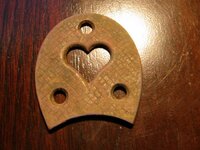Erik in NJ
Silver Member
- Oct 4, 2010
- 4,037
- 3,043
- 🥇 Banner finds
- 1
- Detector(s) used
- Minelab Explorer SE Pro & CTX-3030
- Primary Interest:
- Metal Detecting
Hi! I got out on Saturday for a day or hunting with one of my very good friends--NJLargeCent. He got permission to the grounds of a log cabin house that dates back to ca 1900--not ancient, but any day with nice weather and good company is a treat. The finds were a bit scarce on this property, though we both found a few things.
The best find of my day was something I have been wanting to find for a long time: My first heel plate--it has the three mounting holes and a heart motif. It's on the small side measuring 1-1/2" across its widest part. Ironically my friend Greylock found an identical heel plate the following day. Would love top know more about when these were in use. Mine is missing a chunk, which I don't think I did as there was no bare metal exposed on the edge. I believe it to predate the house, so it may have been done when the property was graded for the house. It was perhaps my deepest item that day!
Other items of note were the buckle with two posts and the escutcheon. There's the body of what appears to be a wristwatch, but I believe it is a toy as the metal is extremely thin. I found a nice looking button, but I believe it to be aluminum and relatively modern.
Also found by me was a large old clock about the diameter of a grapefruit and a Tootsietoy truck and a Lesney Police car (not pictured).
Also pictured are a bridle rosette from my prior hunt and half of a very nice petal (crotal) bell with the name "Parson's [& Smith]" cast into it.
Thanks James for a great day and great company!
The best find of my day was something I have been wanting to find for a long time: My first heel plate--it has the three mounting holes and a heart motif. It's on the small side measuring 1-1/2" across its widest part. Ironically my friend Greylock found an identical heel plate the following day. Would love top know more about when these were in use. Mine is missing a chunk, which I don't think I did as there was no bare metal exposed on the edge. I believe it to predate the house, so it may have been done when the property was graded for the house. It was perhaps my deepest item that day!
Other items of note were the buckle with two posts and the escutcheon. There's the body of what appears to be a wristwatch, but I believe it is a toy as the metal is extremely thin. I found a nice looking button, but I believe it to be aluminum and relatively modern.
Also found by me was a large old clock about the diameter of a grapefruit and a Tootsietoy truck and a Lesney Police car (not pictured).

Also pictured are a bridle rosette from my prior hunt and half of a very nice petal (crotal) bell with the name "Parson's [& Smith]" cast into it.
Thanks James for a great day and great company!

Amazon Forum Fav 👍
Attachments
Last edited:
Upvote
3










 Not sure of any book on heal plates and those heart buckles in question . Originally those heart brass buckles were used as horse tack .The improvising Confederate Soldier saw another use for the buckle, that was as a bed roll buckle. They used this buckle and a leather strap to keep bed rolls tight and neat. I like your find , and the idea it was a calling card in the dirt if you were new in town booty tracker .
Not sure of any book on heal plates and those heart buckles in question . Originally those heart brass buckles were used as horse tack .The improvising Confederate Soldier saw another use for the buckle, that was as a bed roll buckle. They used this buckle and a leather strap to keep bed rolls tight and neat. I like your find , and the idea it was a calling card in the dirt if you were new in town booty tracker . 









